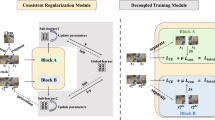Abstract
In recent years, the security of widely used deep learning models has been threatened by adversarial attacks. In this paper, we aim to incorporate a newly proposed metric H-score with the adversarial training framework to further improve model robustness on classification tasks. Specifically, we propose a novel defense method called Dual Feature Distributional Regularization (DFDR) to give dual-level regularization on feature distribution of both normal and adversarial examples, achieving maximal inter-class and minimal intra-class feature distance in a normalized feature space. The experimental results show that our DFDR can not only outperform many other defense methods against adversarial attacks but also improve the adversarial detection results effectively.
Access this chapter
Tax calculation will be finalised at checkout
Purchases are for personal use only
Similar content being viewed by others
References
Athalye, A., Carlini, N., Wagner, D.: Obfuscated gradients give a false sense of security: circumventing defenses to adversarial examples. arXiv preprint arXiv:1802.00420 (2018)
Feinman, R., Curtin, R.R., Shintre, S., Gardner, A.B.: Detecting adversarial samples from artifacts. arXiv preprint arXiv:1703.00410 (2017)
Goodfellow, I.J., Shlens, J., Szegedy, C.: Explaining and harnessing adversarial examples. arXiv preprint arXiv:1412.6572 (2014)
He, W., Wei, J., Chen, X., Carlini, N., Song, D.: Adversarial example defense: ensembles of weak defenses are not strong. In: 11th \(\{\)USENIX\(\}\) Workshop on Offensive Technologies (\(\{\)WOOT\(\}\) 17) (2017)
Huang, S.L., Xu, X., Zheng, L., Wornell, G.W.: An information theoretic interpretation to deep neural networks. arXiv preprint arXiv:1905.06600 (2019)
Ma, X., et al.: Characterizing adversarial subspaces using local intrinsic dimensionality. arXiv preprint arXiv:1801.02613 (2018)
Madry, A., Makelov, A., Schmidt, L., Tsipras, D., Vladu, A.: Towards deep learning models resistant to adversarial attacks. arXiv preprint arXiv:1706.06083 (2017)
Moosavi-Dezfooli, S.M., Fawzi, A., Frossard, P.: DeepFool: a simple and accurate method to fool deep neural networks. In: Proceedings of the IEEE Conference on Computer Vision and Pattern Recognition, pp. 2574–2582 (2016)
Mustafa, A., Khan, S., Hayat, M., Goecke, R., Shen, J., Shao, L.: Adversarial defense by restricting the hidden space of deep neural networks. arXiv preprint arXiv:1904.00887 (2019)
Ross, A.S., Doshi-Velez, F.: Improving the adversarial robustness and interpretability of deep neural networks by regularizing their input gradients. In: Thirty-second AAAI Conference on Artificial Intelligence (2018)
Szegedy, C., et al.: Intriguing properties of neural networks. arXiv preprint arXiv:1312.6199 (2013)
Zhang, H., Yu, Y., Jiao, J., Xing, E.P., Ghaoui, L.E., Jordan, M.I.: Theoretically principled trade-off between robustness and accuracy. arXiv preprint arXiv:1901.08573 (2019)
Zheng, S., Song, Y., Leung, T., Goodfellow, I.: Improving the robustness of deep neural networks via stability training. In: Proceedings of the IEEE Conference on Computer Vision and Pattern Recognition, pp. 4480–4488 (2016)
Zheng, Z., Hong, P.: Robust detection of adversarial attacks by modeling the intrinsic properties of deep neural networks. In: Advances in Neural Information Processing Systems, pp. 7913–7922 (2018)
Acknowledgement
The research of Shao-Lun Huang was supported in part by the Natural Science Foundation of China under Grant 61807021, in part by the Shenzhen Science and Technology Program under Grant KQTD20170810150821146, and in part by the Innovation and Entrepreneurship Project for Overseas High-Level Talents of Shenzhen under Grant KQJSCX20180327144037831.
Author information
Authors and Affiliations
Corresponding author
Editor information
Editors and Affiliations
Rights and permissions
Copyright information
© 2021 Springer Nature Switzerland AG
About this paper
Cite this paper
Li, M., Xu, X., Huang, SL., Zhang, L. (2021). Dual Feature Distributional Regularization for Defending Against Adversarial Attacks. In: Mantoro, T., Lee, M., Ayu, M.A., Wong, K.W., Hidayanto, A.N. (eds) Neural Information Processing. ICONIP 2021. Communications in Computer and Information Science, vol 1517. Springer, Cham. https://doi.org/10.1007/978-3-030-92310-5_44
Download citation
DOI: https://doi.org/10.1007/978-3-030-92310-5_44
Published:
Publisher Name: Springer, Cham
Print ISBN: 978-3-030-92309-9
Online ISBN: 978-3-030-92310-5
eBook Packages: Computer ScienceComputer Science (R0)




